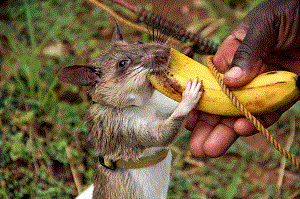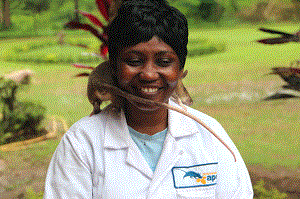
According to Apopo, a nonprofit founded in Belgium that breeds and trains the rats, it could take a person with a metal detector up to four days to clear an area the size of a tennis court. In some countries, such as Colombia, where many mines were homemade, the relative lack of metal components makes the going slow. Scrap metal can also impede the process.
Samia clears the same ground in 30 minutes. The best part: She literally works for peanutsanother favorite snack for the rats. Any day now, Apopo says Samia will be deployed to Angola, where a 27-year civil war that ended in 2002 left swaths of the country covered in mines. Some of her fellow recruits could be heading to Cambodia, Mozambique or Colombia.
Rats often get a bit of a bad rap, said Kelly Marnewick, a senior trade officer at South Africas Endangered Wildlife Trust, which is working with Apopo on one of the rat-training programs. Here are rats that are saving human lives. At 2 to 3 pounds, the rats are too light to set off a land mine.
In 2016, 8,605 people were killed or injured by land mines or other explosive remnants of warmost of them civiliansaccording to the International Campaign to Ban Landmines. The idea of training rats to detect mines was hatched in 1995, when Bart Weetjens, co-founder of Apopo, was working on technologies for developing countries and examining the global land mine problem. The owner of pet rats, he came across a project that was using gerbils as scent detectors and decided to try it with rats.
Unlike demining dogs, the rats dont bond with any specific handler, which makes them easier to transfer from person to person over their seven-to-eight-year lifespan, more than double that of a typical lab rat. And at 2 to 3 pounds in weight, the rats are too light to set off a land mine. In 20 years, no rat has been killed in the line of duty, according to Apopo.
That doesnt mean their trainers dont get worried. Pendo Msegu, a rat-training supervisor at Apopo, which operates with acknowledged irony under the pest-control department of the local university, says she often texts her colleagues in Cambodia to see how her recent graduates are coping.
It makes me happy to see my animals happy, Ms. Msegu said, stroking a young rat named Vishal, who was perched on her shoulder. As a teacher, I have to treat them as an equal to have a nice rat.

Since Apopo started the rat-training program in 1997, the rodents have branched out from land mines. Some, like Carolina, who is almost 2 years old, fight a different type of battle: sniffing out tuberculosis. By 2016, the rats had identified 10,000 TB-positive patients whose infections went undetected by local clinics. Ms. Marnewick hopes that the rats will also be able to sniff out endangered pangolinsbelieved to be the worlds most-trafficked mammalat African ports before they are shipped to Asia, where their scales are prized in traditional medicine and their meat is considered a delicacy.
Eleven of Apopos finest are now in training for the job, including rats named Thoreau, Attenborough and Betty White. Staff members submit names for the rodentssoap-opera characters are also frequent choices. But it has been a long road. There was skepticism in the beginning, said Joaquim da Costa, Angola director for Norwegian Peoples Aid, a humanitarian organization that works to remove land mines. The group, which began using the rats in 2012, says they have made land-mine removal in Angola both easier and faster. But there are some unusual drawbacks.
The rats are weather sensitive, Mr. da Costa said, near flat-out refusing to work in the rain. Naturally nocturnal, the rats have a questionable work ethic after 10 a.m., when temperatures are higher, he added. When the Cambodian Mine Action Center began using Apopos rodents in 2016, some in the organization were skeptical. CMAC personnel followed behind every whiskered-worker with a metal detector, re-clearing the fields, but the rats never missed a mine, Apopo said. Since then, feelings have shifted. One local favorite, Nisay, received a funeral to commemorate her life and service after she died last year from an illness. Her tombstone reads: The Hero Rat. Apopos Cambodia manager, Paul McCarthy, described her as a valued colleague and a real character.
Cindy Fast, head of training and behavioral research at Apopo, said she sees opportunities to deploy the rats in developed countries, for instance to detect food-borne illnesses, such as salmonella or support search-and-rescue operations during disasters.
There is little risk of the rats escaping, she said. When [the trainers] take the harnesses off in the field, the rat can literally make a run for it, but they trot behind the trainers, tail kind of wagging like a dog, she said. You can almost see the smile on their face.
Of the approximately 850 rats that Apopo has bred over the last two decades, fewer than 10% have failed basic training, Ms. Fast said. Those who dont make it through the rat race head to the rat-retirement kennel in Morogoro, where old TB-detection rats also reside. Ms. Fast called it kind of like Florida.
Wexler, Alexandra, How Giant African Rats Are Saving Lives
in Former War Zones, The Wall Street Journal, May 4, 2018
To learn more about GHA and how your property can be greener, jump to Green Hotels Association®!
or CALL 713/789-8889 TODAY!


